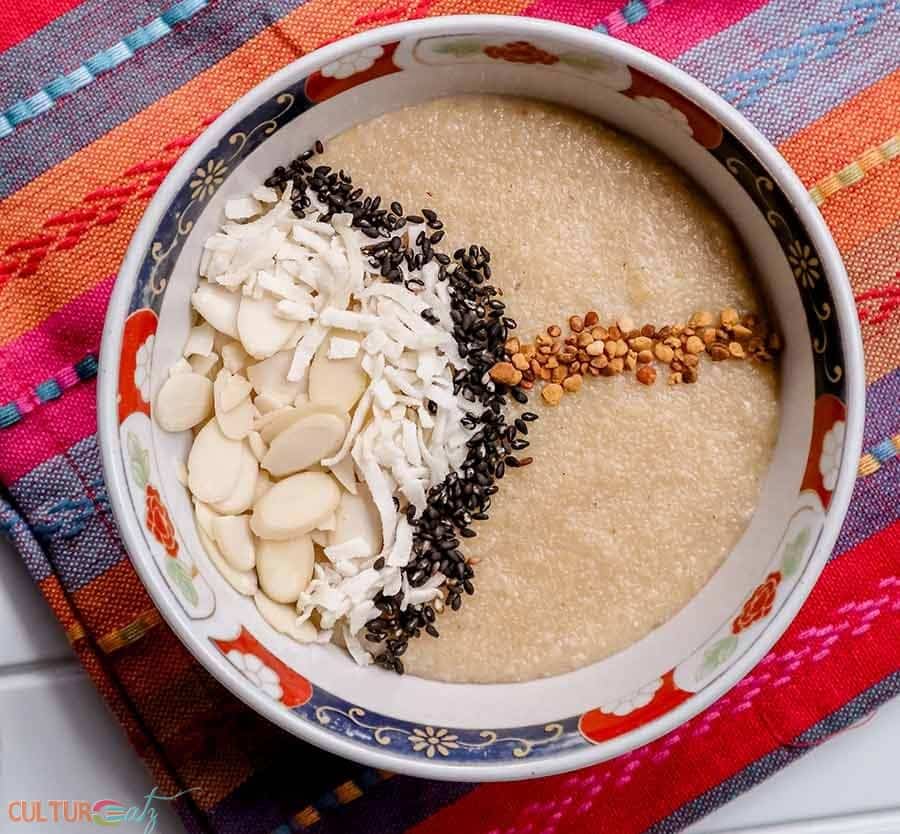
Uji, also known as the Kenyan Fermented Porridge, is the ultimate comfort breakfast food that is packed with probiotics. It is made of dried maize, millet, and/or sorghum that is made wet with water and left to ferment for a few days before cooking.
Fermented foods and fermented drinks are all the craze. They have been for a while and there seems to be no end in sight for this trend. It must mean the health benefits of fermented foods are really good for you. And everyone is scrambling to come up with the next fermented recipe idea. Well, turns out the Kenyans have been doing it all along with the Uji breakfast staple, a Fermented Porridge that is quick to prepare once you have nicely aged your flours with water.
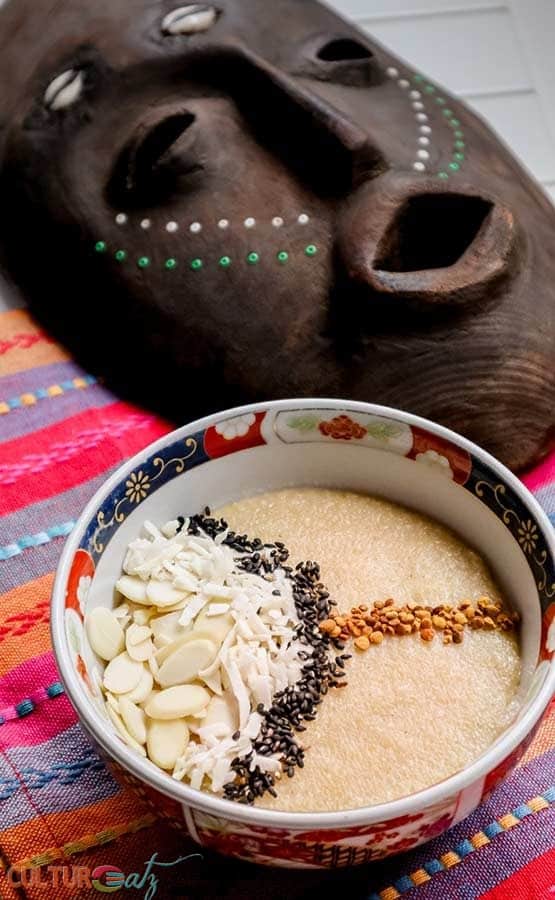
I just got back from a Travel Influencer conference – Women in Travel Summit or WIST18 – that was held this past weekend in Quebec City. It was my first travel conference and how cool that the first international destination the organization picks happens to be only 250km from me! It was an absolute blast and I will tell you more about it soon on the blog.
But man, I tell you, I have travel fever. Imagine 400 women talking about their favorite travel destinations! A few had mentioned traveling to Kenya. What a coincidence as it happens to be this month’s country for Eat the World! I am so happy to add Kenya to the list of countries I have cooked from so far on CulturEatz with a Kenyan porridge.
Now let’s get on with how to cook porridge with fermented grains. From this one recipe, you can make all types of porridge. Choose a mix of grains, grind it and you can make a flour porridge.
I have a FREE PRINTABLE for you
Surprise! I have prepared a Cheat Sheet that includes 41 Cooking and Baking Ingredient Substitutions that are commonly found in a kitchen. Click here to get your FREE Ingredient Substitutions Cheat Sheet right now!

Uji, a Kenyan Fermented Porridge
I made my Uji porridge with a mix or cornmeal and millet flour. I took regular millet and whizzed it in my spice grinder. Often you will find only sorghum in this sorghum porridge recipe but all mixes are acceptable. In specialty stores, you can even buy a Uji mix. Once you have mixed the flours, simply wet them with water, cover, and leave on the counter for 2 to 3 days.
That is when fermented magic happens. All the yumminess of fermented porridge that comes from either millet porridge, maize meal porridge, and/or a sorghum porridge recipe. And it is gluten-free with these grains. Plus using water is how to prepare porridge in this recipe, hence making it dairy-free.
When it is time for breakfast, bring some water to boil, add your mixture and leave it to cook for a few minutes. You can play around with the amount of water to get a more solid or liquid consistency. Add a little sweetener – I used honey – and top with nuts or dried fruits if you like. It was a total fluke that my topping turned into a pretty tribal design, next to a Kenyan mask I picked up in NYC a few years back.
How cool is my floating spoon trick below!
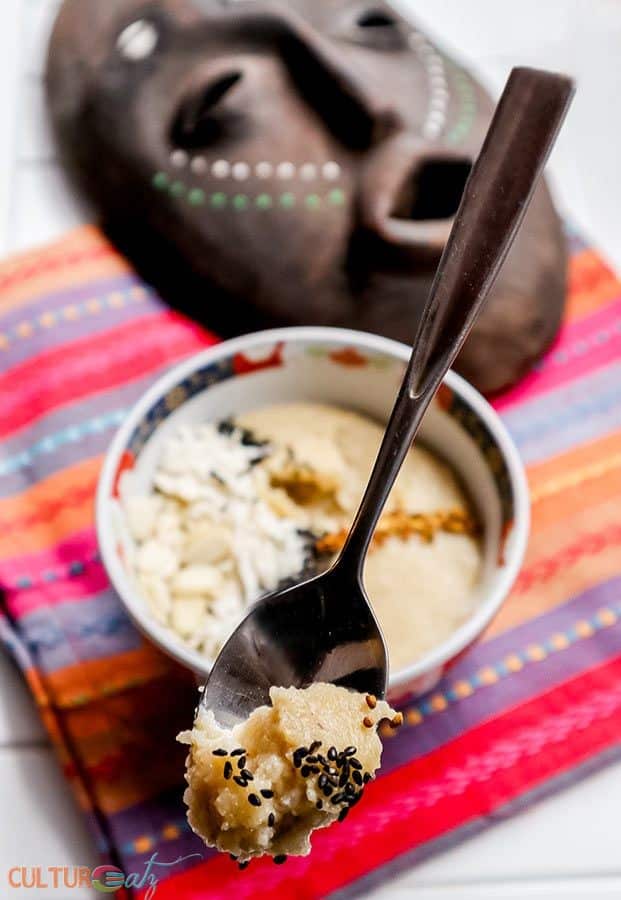
Why are fermented foods good for you?
Healthy fermented foods are made by setting up the ingredients to encourage Lacto-fermentation, like this fermented honey with garlic recipe. This process encourages the natural bacteria to feed on the sugar and starch in the ingredients, creating lactic acid and probiotics.
How did this African porridge taste? I must admit it was a bit special. Once the sweetener is added you get a sweet squash-like taste with just a note of cheese. Not bad but I am not sure it is something I would personally reach for instinctively in the morning.
Perhaps it is a bit of an acquired taste if you are not raised on it. But considering all the probiotic benefits I would take up the Uji challenge of making porridge again.
Check out my other fermented recipes:
- sourdough starter for bread
- Chinese Laba garlic
- fermented honey with garlic
- Polish White Borscht Soup
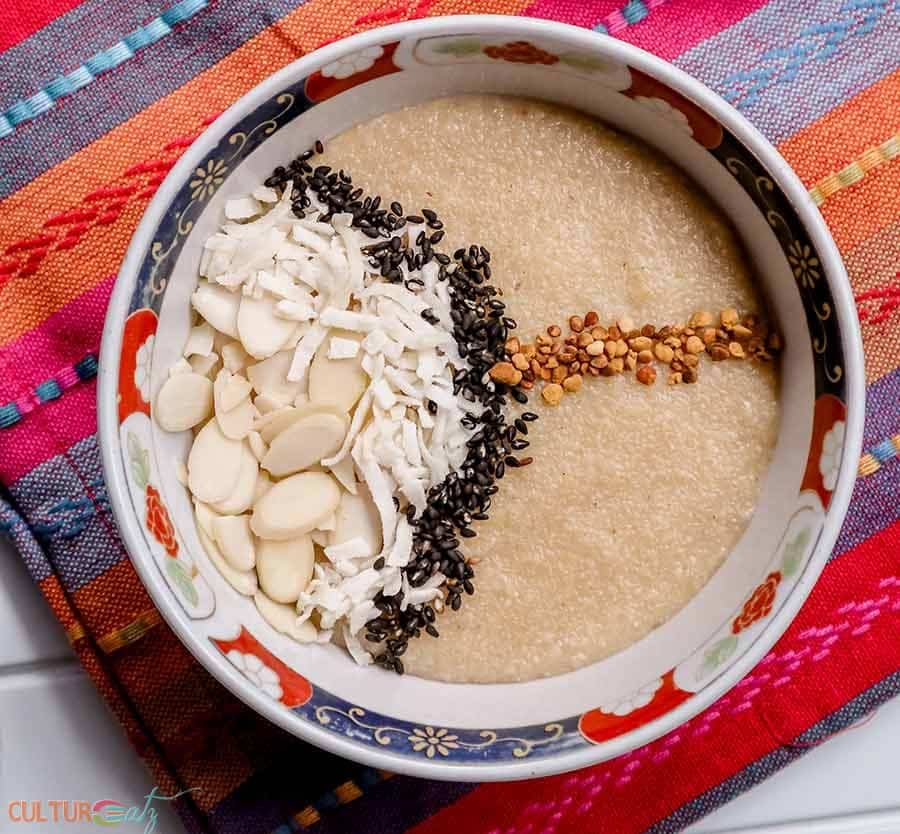
Uji, a Kenyan Fermented Porridge
Ingredients
- 1/4 cup cornmeal
- 1/4 cup millet flour
- 1/4 cup water + 1 1/2 cup water
- Sweetener to taste
Instructions
- Mix well the corn meal and millet flour with a 1/4 cup of water. Cover and leave to rest at room temperature for 2 to 3 days. This will ferment the mixture.
- Bring 1 1/2 cup of water (more or less check consistency) to a boil, add the mixture and lower heat to a simmer. Stirring continuously, cook for 3 to 5 minutes. Add more water as needed. Add sweetener to taste, like honey. Serve into 2 bowls and top with nuts of fruits if desired. 2 servings.
Notes
So tell me…
- Do you enjoy the benefits of fermented foods?
- Do you like preparing and cooking porridge?
- How often do you eat porridge?
Eat the World Challenge
Check out all the wonderful Kenyan dishes prepared by fellow Eat the World members and share with #eattheworld. Click here to find out how to join and have fun exploring a country a month in the kitchen with us!
Wendy: Kenyan Pilau
Camilla: Kuku Paka + Irio
Tara: Chapati Za Ngozi (Kenyan Soft-Layered Chapati)
Margaret: Maharagwe & Ugali (Red Beans in Creamy Coconut Sauce with Cornmeal Slices)
Amy: Crunchy N’Dizi
Heather: Irio
Juli: Nyama Choma
Loreto and Nicoletta: Mango Ice Cream with Pineapple Rum Sauce (Coupe Mount Kenya)
Evelyne: Uji, a Kenyan Fermented Porridge
PIN IT FOR LATER https://www.pinterest.ca/pin/266275396703434369
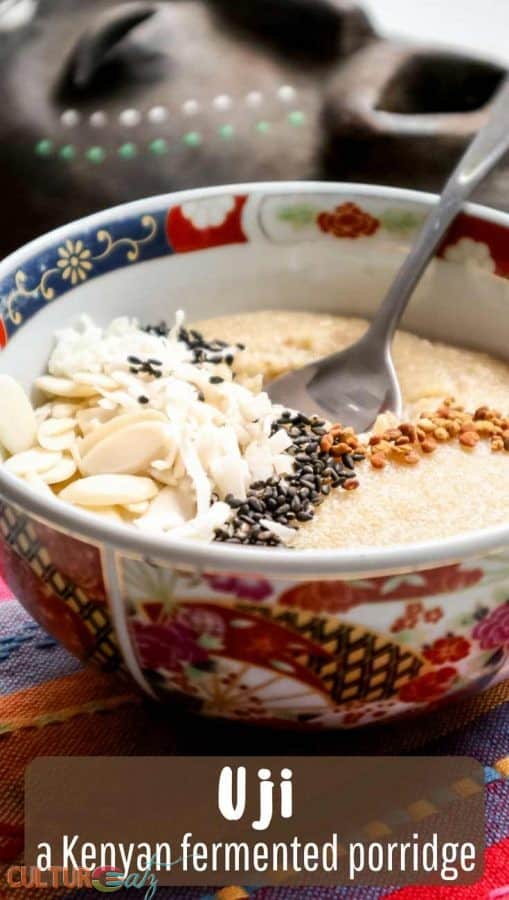
Check out more African recipes here:




Interesting recipe. Never thought to ferment porridge. Do you know if it’s possible to ferment ground buckwheat using this method? Buckwheat is also a seed. Is it possible to add other things into the ferment, like ground nuts?
How do you know if the ferment is good or not, which bacteria are in it? Normally lacto-fermented foods have salt added.
Kind regards,
Tom
Hi Tom and thank you for your in-depth questions. I am not an expert in fermenting food, I just tried this unique recipe looking to try a Kenyan food. Since I am not an expert, I don
You realize boiling it after fermentation is going to kill all the probiotics you are trying to ingest?
You can ferment after cooking however to preserve the bacteria for 12-24 hours.
Actually we are not boiling it, we bring the water to a boil, and lower the heat to a simmer. Hot water is at 100C and probiotics live up to 80C.
Also, several studies have found that heat-killed bacteria still exhibit many of the same or similar health benefits as their live counterparts. Additionally, some bacteria survived after being frozen for 11 weeks. Also, look up Tyndallization, if we kept it boiling, the heat will kill the bacterial cells; however, bacterial spores capable of later germinating into bacterial cells may survive.
I know some different recipe of making Uji but your recipe seems lovely and delicious. Thanks for sharing. Gonna try once.
Thank you Alysia, I hope you give this one a try. I am curious as to which recipe you use?
It seems I was doing all wrong to make uji perfectly! My kids likes to have this dish on their breakfast. Now they are going to have some different upgraded test I hope! Thanks Evelyne for your nice post.
Thank you Andrea for your comment and I know what you mean, there are so many odd versions out there. I hope your kids like this version!
Love the sound of this, I’ve not tried anything similar before!
Thanks Caroline, I hope you give this one a shot, it’s unique!
Mmmm fermented? I might not be brave enough to try this but well, you only live once so I will still give it a shot. Reminds me of Japanese Nato when I see breakfast and fermented
Oh this is a piece of cake compared to natto lol Raymond. You can skip the fermentation process by adding 3 cups of water and cooking the mixture longer, about 10-15 minutes on a simmer. Or try 1-day fermentation.
You always expand my food knowledge. I don’t think I can name more than one African recipe (one being your uji!). You’ve made a beautiful porridge and it would definitely be a yummy, hearty breakfast!
I love it when you find my recipe a completely new discovery, this one was totally new for me too. To try in the new kitchen!
I’ve never heard of this but I think I’d really like it! It’s so cold here now (ok not Canada cold but Australia cold 😉 ) that I want to eat porridge all the time 😀
It’s not been a hot spring, probably similar weather. And yes totally a perfect breakfast for warming up and getting healthy!
I am a real porridge lover. It’s my comfort food. You’ve got me totally intrigued to see what the flavours of this porridge are like – is it like the sourdough version of oatmeal? I think I’ve gotta try it! (And am also waiting in anticipation of your spoon trick reveal and the next country reveal!)
Well you must try this one Margaret then. Hmm yeah, sourdough, squash, a bit of cheese…all in the flavor profile, but texture more like a cream of wheat.
Neat stuff! I haven’t heard of this and certainly haven’t eaten it, but it sounds interesting. And tasty. Fermented foods can be awesome — this sound so healthy. And tasty. Did I mention tasty? 🙂
John, I get the feeling you like fermented foods that are tasty, did I get that right LOL? Thanks!
This is really interesting. I’d like to try it out, but maybe would prefer the pre-mixed version to see if I like it.
Awesome pictures, too!
Well from what I see the bags are big. You could try it with just cornmeal to see.
We all need more probiotics :-)) The porridge looks really delicious, Evelyne. Love to see how you did that floating spoon!
I totally see you trying this recipe Angie 🙂 The spoon is creating a big stir (HAHA pun intended) so I may make a tutorial next week!.
We love fermented foods, but I have never seen this kind of preparation. Can’t wait to try it. Thanks for sharing…and for nudging us out of our comfort zones for this month’s adventure. What’s next?!? I’m ready.
it was so new to me too! So excited the announcement will be in 2 days for our next trip!
So neat with the floating spoon! We need more probiotics around here.
Amen to healthy probiotics for a happier health. I may do a tutorial on the spoon!
I’m very impressed with your floating spoon. I agree that fermented foods take some getting used to.
Cool trick lol with the spoon. maybe I’ll do a tutorial on it soon. Yeah, some fermented foods are unique in taste.
So easy to make, it would be interesting to taste! I think I’d like the overall flavor and the porridge-like texture. It looks very pretty, too! Would make a good and healthy alternative for breakfast. Thank you, Evelyne!
P.s. We’re having so much fun, can’t wait for the next country to be revealed 😉 .
Very easy for sure and very different lol. So glad you are having fun and the next country will be revealed in 2 days. So excited 😀
I love porridges or any kind, and that looks interesting. I can’t wait to try it.
Thank Juli, this one is unique for sure 🙂